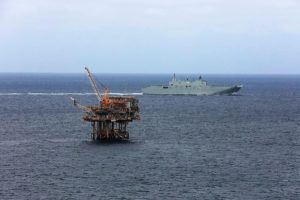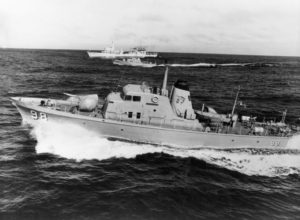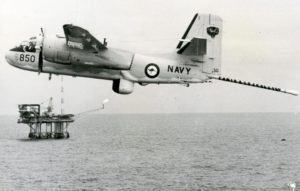By Midshipman Lloyd Skinner, RAN
Beginning in 1980, Operation Estes saw the government call upon the Australian Defence Force (ADF) to conduct regular surface patrols around Bass Strait. Aerial and surface surveillance was carried out by the Royal Australian Air Force (RAAF) and Royal Australian Navy (RAN) warships which provided the backbone for the Bass Strait Oil Rig Surveillance (BSORS) operation. Bass Strait is an economically important area for Australia because of the many offshore oil installations located in it which were ostensibly vulnerable to perceived threats such as non-state terrorist activity and ship collisions.

In 1980, a near miss from a merchant vessel in Bass Strait was a catalyst for the operation as it narrowly avoided colliding with an oil rig. The consequences of an event such as this were viewed by the government as catastrophic. A collision with an offshore fuel installation posed a serious threat to Australian fuel supplies, and hence, the economy. This is not to mention risks to the integrity of the oil field and the environmental damage to the Australian coast and ocean caused by a fuel spill.
Additionally, following the Sydney Hilton Hotel bombing on 13 February 1978, terrorism had pivoted itself into the national mindset. Fears that the endangered oil installations could be subject to violent takeover from terror groups aiming to directly harm the Australian fuel supply compounded the need for a counterterrorist military presence in this domain. As a consequence, Special Air Service Regiment personnel would be tasked with undertaking the counterterrorist segment of BSORS under Operation Bursa. Ships and aircraft of the RAN and RAAF were called upon to undertake surveillance of shipping that transited the Strait.
As a further precaution against a potential oil rig disaster the Federal Government decreed the area around the Bass Strait oil field as ‘restricted’ and instituted a safety zone around each installation. The ADF would also be tasked with patrolling the area. The role of the ADF was to detect approaching merchant ships that had a gross tonnage of over 200 tonnes and, if necessary, prevent them breaching restricted area boundaries. Patrolling aircraft and vessels had to also prevent all ships, apart from rig tenders, from entering the 500-metre safety zone around each installation.

RAN ships involved in Operation Estes mainly compromised Attack and Fremantle Class patrol boats. HMAS Fremantle saw near continual engagement in the BSOR operations. Similarl, HMAS Barbette, conducted regular patrols in Bass Strait. When Fremantle became unserviceable the Ton Class Minesweeper, HMAS Ibis was called upon to maintain a continuous presence in this strategic domain vital to Australian interests. The Huon Class Minehunters, HMAS Norman and Hawkesbury were also involved in later years.
One can imagine the discomfort of life aboard a small warship in the boisterous and rough sea states of the Bass Strait. Lawson Rennie who was a crew member aboard a patrol boat conducting BSORS spoke of having to eat sandwiches, as meals could simply not be cooked when these small vessels were tossed amongst large swells.
Many contemporary RAN warships continue to carry out surface surveillance today. Larger warships such as Guided Missile Frigate, HMAS Darwin, Support Ship HMAS Success and Landing Helicopter Dock, HMAS Adelaide all conducted BSORS patrols. This demonstrates that successive governments continue to recognise the economic criticality of the offshore fuel installations and acknowledge the requirement for their protection.
Royal Australian Navy S2 Grumman Tracker aircraft commenced aerial surveillance sorties on 24 December 1980 in conjunction with surface patrols by RAN ships. The Trackers flew two out of every three days. RAAF Orion aircraft continued to fly on the third day. 816 Squadron of the RAN was the unit that undertook the tasking up until 11 January 1982, when 851 Squadron inherited the responsibility. Approximately 2500 hours of aerial surveillance were carried out by the S2 Trackers from the beginning of the operation to the cessation of their involvement on 31 December 1983. The Chief of Naval Staff stated in a signal addressed to 851 Squadron that the operation reflected “credibility on the professionalism of the Fleet Air Arm. All personnel… are commended for their achievement.”

While Fleet Air Arm involvement in the operation had ended, RAN warships, consisting mainly of patrol boats continued to carry out surface BSORS and anti-terrorist patrols.
Bibliography
RAN Trackers Cease Bass Strait Oil Rig Patrols. ”Fleet Air Arm Association of Australia, 27 Jan. 1984
www.faaaa.asn.au/wpcontent/uploads/2018/12/TrackerStoryNN27Jan84.jpg
Royal Australian Navy. “HMAS Ibis (II).”www.navy.gov.au, www.navy.gov.au/hmas-ibis-ii. Accessed 7 Dec. 2020.
Navy, Royal Australian. “HMAS Darwin ”www.navy.gov.au, www.navy.gov.au/hmas-darwin. Accessed 7 Dec. 2020.
Navy, Royal Australian. “Grumman S-2E/G Tracker.”www.navy.gov.au,
www.navy.gov.au/aircraft/grumman-s-2eg-tracker. Accessed 7 Dec. 2020.
Releases, DP Press. “HMAS Adelaide Conducts Patrol in Bass Strait Oil Rig Restricted
Area.”DefPost, 4 April 2018, defpost.com/hmas-adelaide-conducts-patrol-bass-strait-oil-rig-restricted-area/. Accessed 7 Dec. 2020.




